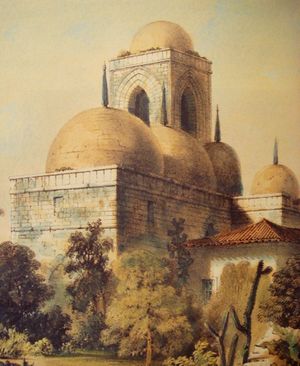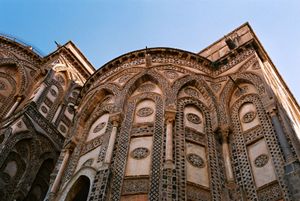الثقافة النورمانية-العربية-البيزنطية

مصطلح الثقافة النورمانية-العربية-البيزنطية,[1] Norman-Sicilian culture[2] أو، الأقل شمولاً، الثقافة النورمانية-العربية أو الثقافة العربية-النورمانية،[3] (يشار إليها أحياناً "بالحضارة النورمانية-العربية")[4][5][6][7] يشير إلى التفاعل بين الثقافات النورمانية، العربية والبيزنطية في أعقاب الغزو النورماني لصقلية من 1061 حتى ح. 1250. أسفرت هذا التفاعل عن عدد من التغيرات في المجالات الثقافية والعلمية، والذي اعتماد على التسامح الذي أظهره النورمان تجاه الشعوب الناطقة باليونانية[8] والمستوطنين المسلمين. نتيجة لذلك، أصبحت صقلية تحت حكم النورمان مفترق طرق للتفاعل بين الثقافات النورمانية-الكاثوليكية، البيزنطية-الأرثوذكسية والعربية-الإسلامية.
الغزو النورماني لجنوب إيطاليا
استولى النورمان صقلية من أيدي العرب، وكان النزاع الداخلي سببا في الانقسام بين الأمراء العرب، وكان ابن الثمنة، قد طلب المساعدة من النورمان للقضاء عليهم. ودخل النورمان باليرمو عام 1072 م، ولكن لم يكتمل فتحهم للجزيرة إلا عام 1091 م. وتداول على حكم صقلية أربعة من الحكام النورمان وهم: روجر الأول (ت1101 م) وروجر الثاني (ت1154 م) ووليام الأول (ت1166 م) ووليام الثاني (ت1189 م). والغريب في الأمر ان النورمان في صقلية ذهلوا بالحضارة التي خلفها أسلافهم العرب فيها وأعلنوا حمايتهم لها وأظهروا رغبتهم في الاحتفاظ بها ووقفوا تحية أجلال أمام حضارة العرب.[9]
التفاعلات الثقافية



الفن النورماني-العربي-البيزنطي

العمارة النورمانية-العربية-البيزنطية

النقل إلى أوروپا
التبعات


انظر أيضاً
- الإسلام في إيطاليا
- نورمان-إيطاليون
- تاريخ الإسلام في جنوب إيطاليا
- الغزو النورماني لجنوب إيطاليا
- إمارة صقلية
- Hedwig glass
الهوامش
- ^ Michael Huxley: "The Geographical magazine", Vol. 34, Geographical Press, 1961, p. 339
- ^ Gordon S. Brown: "The Norman conquest of Southern Italy and Sicily", McFarland, 2003, ISBN 0786414723, p. 199
- ^ Moses I. Finley: "A History of Sicily", Chatto & Windus, 1986, ISBN 0701131551, pp. 54, 61
- ^ "In Sicily the feudal government, fastened on a country previously turbulent and backward, enabled an Arab-Norman civilization to flourish." Edwards, David Lawrence (1980). "Religion". Christian England: Its Story to the Reformation. p. 148.
- ^ Koenigsberger, Helmut Georg. "The Arab-Norman civilization during the earlier Middle-Ages". The Government of Sicily Under Philip II of Spain. p. 75.
- ^ Dossiers d'Archéologie, 1997: "It is legitimate to speak about an Arab-Norman civilization until the 13th century" (Original French: "on est fondé à parler d'une civilisation arabo-normande jusqu'au XIIIeme siècle" [1]
- ^ Abdallah Schleifer: "the monuments of a great Arab-Norman civilization" [2]
- ^ Lynn White, Jr.: "The Byzantinization of Sicily", The American Historical Review, Vol. 42, No. 1 (1936), pp. 1-21
- ^ http://www.iraqisg.org/ShowNews.php?id=4636
- ^ Les Normands en Sicile
- ^ Les Normands en Sicile, p. 54.
المصادر
- Buttitta, Antonino (ed.). Les Normands en Sicile. Caen: Musée de Normandie. ISBN 8874393288.
- Amari, M. (2002). Storia dei Musulmani di Sicilia. Le Monnier.
- Aubé, Pierre (2006). Les empires normands d’Orient. Editions Perrin. ISBN 2262022976.
- Lebédel, Claude (2006). Les Croisades. Origines et conséquences. Editions Ouest-France. ISBN 2737341361.
- Lewis, Bernard (1993). Les Arabes dans l'histoire. Flammarion. ISBN 2080813625.
- Musca, Giosuè (1964). L'emirato di Bari, 847-871. Bari: Dedalo Litostampa.
- Previte-Orton, C. W. (1971). The Shorter Cambridge Medieval History. Cambridge: Cambridge University Press.
- Taylor, Julie Anne (April 2007). "Freedom and Bondage among Muslims in Southern Italy during the Thirteenth Century". Journal of Muslim Minority Affairs. 27 (1): pp. 71–77. doi:10.1080/13602000701308889.
{{cite journal}}:|pages=has extra text (help); Cite has empty unknown parameter:|quotes=(help) - Santagati, Luigi (2012). Storia dei Bizantini di Sicilia. Lussografica.

